Yanagisawa: The first in eastern Japan. The recovery of multiple bronze halberds buried with a bronze bell. A great discovery calling for reevaluation of ritual and social structure for the Middle Yayoi of eastern Japan.

Cached bronze
halberds and bell
Although a portion of
the pit was cut away on its northern side, it measured 66 cm
east-west and was 17 cm deep, in which 7 bronze halberds (of which 2
items were removed at the point of discovery) and 1 bronze bell were
lined together without interval and buried. These 5 halberds were
stood on their blade edges, with the tips pointing to the west
(toward Chikuma river). The 4 items in the back
(Nos. 1-4) were laid
with their backs and fronts facing alternate directions. The bronze
bell was buried to the east of the halberds, and was found with the
fins in a horizontal position, and the handle inclined slightly
downward.

The Yanagisawa
site spreading over the western base of Mt. Kōsha
The Yanagisawa site
lies atop an alluvial fan on the western base of the exquisitely
beautiful Mt. Kōsha, at the point where the Chikuma and Yomase
rivers converge. Yayoi period remains found here include 6 pit
dwellings, 2 cemeteries, paddy and irrigation ditches (see the
separate diagram of the features). Adapted from Hakkutsu sareta
Nihon rettō 2009 [Excavations in the Japanese Archipelago, 2009]
(Bunkachō [Agency for Cultural Affairs], ed., Asahi Shimbun
Publications, 2009).

Features at the
Yanagisawa site
Adapted from Hakkutsu
sareta Nihon rettō 2009 [Excavations in the Japanese
Archipelago, 2009] (Bunkachō [Agency for Cultural Affairs], ed.,
Asahi Shimbun Publications, 2009).
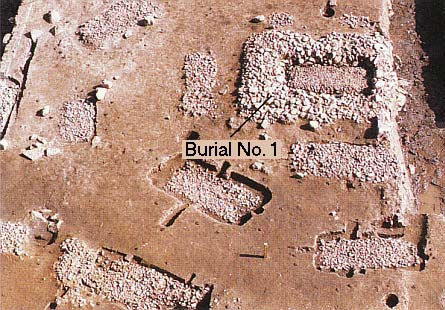
Gravel-bedded wooden coffin burial cluster (from the south) The burial sector was found at a spot about 50 m to the north of the bronze cache, and is thought to be related to the people who buried the bronze implements in the pit. At the upper right in the photo, the burial facility (where the interred was laid) of Burial No. 1 measures 140 cm long by 70 cm wide, about the same as the surrounding graves, but it is surrounded with piled stones approximately 30-50 cm in size, making a large-scale grave more than 250 cm in overall length, and 230 cm wide. Adapted from Hakkutsu sareta Nihon rettō 2009 [Excavations in the Japanese Archipelago, 2009] (Bunkachō [Agency for Cultural Affairs], ed., Asahi Shimbun Publications, 2009).
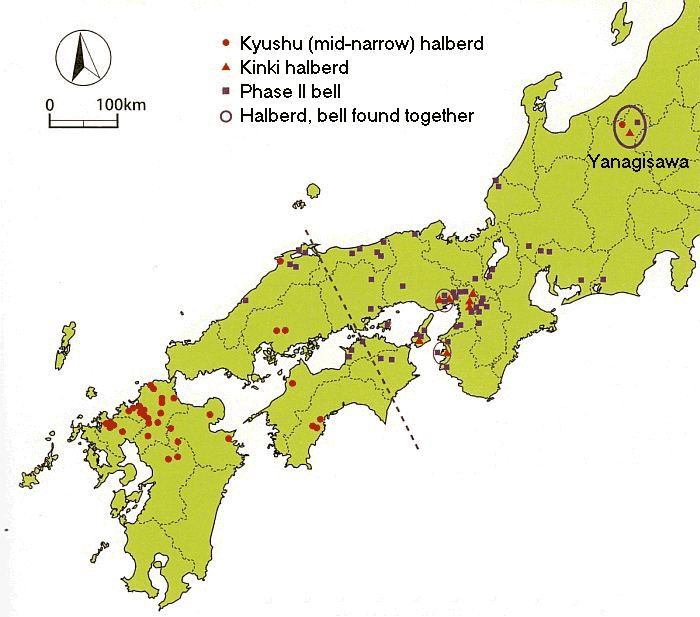
Distributions of Middle Yayoi bronze halberds (mid-narrow blade and Kinki types) and bronze bells (Phases I and II) This is just the second example of multiple halberds buried together with a bronze bell, following Sakuragaoka in Hyōgo prefecture. It is also the first time a complete example of a mid-narrow blade (Kyushu) type being found east of the line connecting Shimane and Kōchi prefectures. Adapted from Hakkutsu sareta Nihon rettō 2009 [Excavations in the Japanese Archipelago, 2009] (Bunkachō [Agency for Cultural Affairs], ed., Asahi Shimbun Publications, 2009); originally produced by the Nagano-ken Maizō Bunkazai Sentâ (Nagano Prefectural Archaeological Research Institute) based on Shimane-ken kodai bunka sentâ chōsa hōkokusho 12 (2002), 32 (2006).
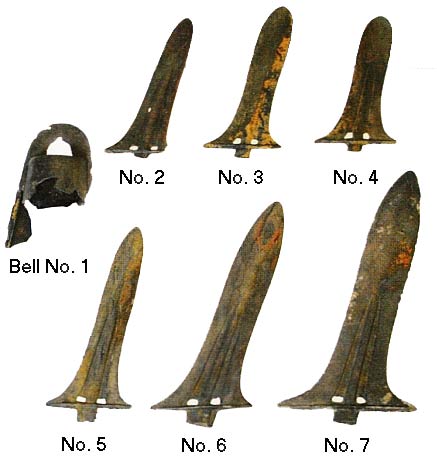
Bronze halberds
and bell found in 2007
Latter half, Middle
Yayoi to the first half, Late Yayoi; approximately 2000 years ago.
Bronze halberd lengths: No. 2, 23.5 cm; No. 3, 25.2 cm; No. 4, 22.2 cm; No. 5, 27.4 cm; No. 6, 32.4 cm; No. 7, 36.1 cm.
Bronze bell height: 22.5 cm (estimated).
All of the halberds were thick in cross-section, displaying characteristics of older examples. There were items with a compound sawtooth pattern cast into the grooves (Nos. 3, 5), and those with bands of diagonal latticework at the borders of the perforations (all but No. 4). Item No. 1 (in the photo below) is of the Kyushu type. In the Kyushu type, the two grooves running down the blade converge at their tips, but in the Kinki type they do not converge.
The bronze bell has a distinct flange on the handle that extends down the sides of the body (Sahara's Phase II-1), and is thought to have been rung in rituals. In addition to the flowing water pattern on the body, the flange has a sawtooth pattern with the tips of the triangles pointing outwards. The band on the inner surface for the clapper to strike is badly worn, and it is thought to have been used over an extended period of time.
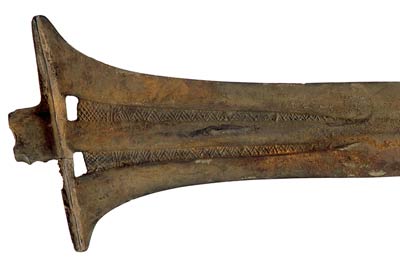
Compound sawtooth pattern and a band of diagonal latticework (No. 5 halberd). 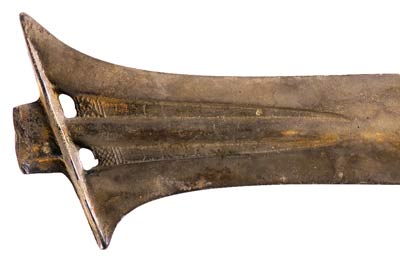
The non-converging troughs of the Kinki type (No. 6 halberd). |
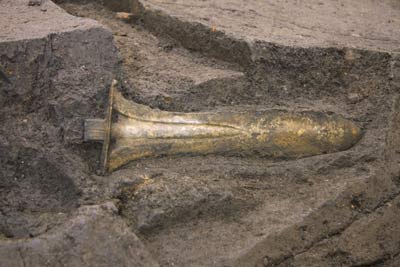
Kyushu type No. 1 halberd in situ. Length: 34.4 cm. 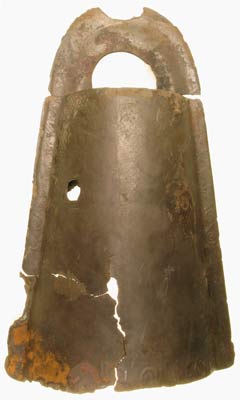
Discovery of
multiple bells |
Yanagisawa Site, Nakano City, Nagano Prefecture
A buried cache of bronzes is discovered in eastern Japan
In 2007, at the Yanagisawa site in northern Nagano prefecture, multiple bronze halberds and a bronze bell, from the latter half of the Middle to the Late Yayoi periods, were found buried in a pit. Until now examples of cached bronze implements were known from the Tōkai region to northern Kyushu, and it was thought that rituals utilizing these items were conducted mostly in western Japan. From the discovery at the Yanagisawa site, it was learned that these rites had spread further east than previously thought.
The numbers of recovered bronzes grows
The bronze halberds found in 2007 included 1 item of the mid-narrow blade type, whose distribution centers on northern Kyushu, and 6 items of the Kinki (Osaka bay) type, the first time these two types have been found deposited together nationwide. Also, the bronze bell was an older example (Phase II in Sahara's typology, around the 2nd century BCE), cast with a flowing water pattern.
During investigations in the following year, when looking for pieces of bronze implements using a metal detector, fragments from 4 bronze bells and 1 bronze halberd were discovered in 2008 in the dirt around the pit. The bells were seen to have a crossed-bands pattern (kesadasukimon).
Whether these newly discovered items had been in the same pit as the cache found in the previous year needs further examination, but a total of 8 bronze halberds and 5 bronze bells had been brought into the Yanagisawa site regardless. The burial of such a large number of bronze bells and halberds is exceedingly rare nationwide.
Evidence for social stratification? A cluster of wooden coffin burials on gravel beds
That the positional relationship of the bronze cache with residential, burial, and economic production sectors has been ascertained at the Yanagisawa site is of great importance. In the burial sector in particular, it was learned in the investigation of 2008 that 17 wooden coffin burials on gravel beds were lined up, surrounding a single large-scale example, Burial No. 1. This type of burial, consisting of a wooden coffin placed in a pit with gravel spread on the bottom, is a special style of mortuary treatment of the Middle Yayoi period with a distribution centering on the Chikuma river drainage. But even in this region, no other example is known of a large-scale grave exceeding 2.5 m in length, with other burials arranged around it in the center. Also, more than 70 thin tubular beads of ferruginous quartz and green tuff were recovered from Burial No. 1.
It seems possible that at the Yanagisawa site, a group with strongly regional burial practices had adopted rituals utilizing bronze implements.
In contrast with western Japan, it had been thought until now that the Middle Yayoi of eastern Japan did not conduct rituals utilizing bronzes, and that social stratification was not highly advanced, but it has become necessary to reconsider the rituals and social structure of eastern Japan. (Hirota Kazuho)
